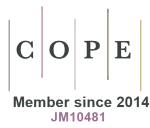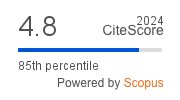Defining the glenohumeral range of motion required for overhead shoulder mobility: an observational study
DOI:
https://doi.org/10.33393/aop.2024.3015Keywords:
Glenohumeral, Postoperative, Range of motion, Rehabilitation, Shoulder, StiffnessAbstract
Background: Recovery of overhead mobility after shoulder surgery is time-consuming and important for patient satisfaction. Overhead stretching and mobilization of the scapulothoracic and glenohumeral (GH) joints are common treatment interventions. The isolated GH range of motion (ROM) of flexion, abduction, and external rotation required to move above 120° of global shoulder flexion in the clinical setting remains unclear. This study clarified the GH ROM needed for overhead mobility.
Methods: The timely development of shoulder ROM in patients after shoulder surgery was analyzed. Passive global shoulder flexion, GH flexion, abduction, and external rotation ROM were measured using goniometry and visually at 2-week intervals starting 6-week postsurgery until the end of treatment. Receiver operating characteristic curves were used to identify the GH ROM cutoff values allowing overhead mobility.
Results: A total of 21 patients (mean age 49 years; 76% men) after rotator cuff repair (71%), Latarjet shoulder stabilization (19%), and arthroscopic biceps tenotomy (10%) were included. The ROM cutoff value that accurately allowed overhead mobility was 83° for GH flexion and abduction with the area under the curve (AUC) ranging from 0.90 to 0.93 (p < 0.001). The cutoff value for GH external rotation was 53% of the amount of movement on the opposite side (AUC 0.87, p < 0.001).
Conclusions: Global shoulder flexion above 120° needs almost full GH flexion and abduction to be executable. External rotation ROM seems less important as long as it reaches over 53% of the opposite side.
Downloads
References
- Magermans DJ, Chadwick EK, Veeger HE, van der Helm FC. Requirements for upper extremity motions during activities of daily living. Clin Biomech (Bristol, Avon). 2005;20(6):591-599. https://doi.org/10.1016/j.clinbiomech.2005.02.006 PMID:15890439 DOI: https://doi.org/10.1016/j.clinbiomech.2005.02.006
- Namdari S, Yagnik G, Ebaugh DD, et al. Defining functional shoulder range of motion for activities of daily living. J Shoulder Elbow Surg. 2012 Sep;21(9):1177-83. doi: 10.1016/j.jse.2011.07.032. Epub 2011 Nov 1. PMID: 22047785.. DOI: https://doi.org/10.1016/j.jse.2011.07.032
- Warner JJ, Greis PE. The treatment of stiffness of the shoulder after repair of the rotator cuff. J Bone Joint Surg. 1997;79(8):1260-1269. https://doi.org/10.2106/00004623-199708000-00020 DOI: https://doi.org/10.2106/00004623-199708000-00020
- O’Holleran JD, Kocher MS, Horan MP, Briggs KK, Hawkins RJ. Determinants of patient satisfaction with outcome after rotator cuff surgery. J Bone Joint Surg Am. 2005;87(1):121-126. https://doi.org/10.2106/JBJS.C.01316 PMID:15634822 DOI: https://doi.org/10.2106/JBJS.C.01316
- Vermeulen HM, Obermann WR, Burger BJ, Kok GJ, Rozing PM, van Den Ende CH. End-range mobilization techniques in adhesive capsulitis of the shoulder joint: a multiple-subject case report. Phys Ther. 2000;80(12):1204-1213. https://doi.org/10.1093/ptj/80.12.1204 PMID:11087307 DOI: https://doi.org/10.1093/ptj/80.12.1204
- Griggs SM, Ahn A, Green A. Idiopathic adhesive capsulitis. A prospective functional outcome study of nonoperative treatment. J Bone Joint Surg Am. 2000;82(10):1398-1407. https://doi.org/10.2106/00004623-200010000-00005 PMID:11057467 DOI: https://doi.org/10.2106/00004623-200010000-00005
- Stenvers JD. Primary frozen shoulder: a retrospective study on treatment with physiotherapy [Doctoral dissertation]: University of Groningen 1994.
- Donatelli R, Ruivo RM, Thurner M, Ibrahim MI. New concepts in restoring shoulder elevation in a stiff and painful shoulder patient. Phys Ther Sport. 2014;15(1):3-14. https://doi.org/10.1016/j.ptsp.2013.11.001 PMID:24315683 DOI: https://doi.org/10.1016/j.ptsp.2013.11.001
- Ludewig PM, Phadke V, Braman JP, Hassett DR, Cieminski CJ, LaPrade RF. Motion of the shoulder complex during multiplanar humeral elevation. J Bone Joint Surg Am. 2009;91(2):378-389. https://doi.org/10.2106/JBJS.G.01483 PMID:19181982 DOI: https://doi.org/10.2106/JBJS.G.01483
- Fayad F, Hoffmann G, Hanneton S, et al. 3-D scapular kinematics during arm elevation: effect of motion velocity. Clin Biomech (Bristol, Avon). 2006;21(9):932-941. https://doi.org/10.1016/j.clinbiomech.2006.04.015 PMID:16774803 DOI: https://doi.org/10.1016/j.clinbiomech.2006.04.015
- Vermeulen HM, Stokdijk M, Eilers PH, Meskers CG, Rozing PM, Vliet Vlieland TP. Measurement of three dimensional shoulder movement patterns with an electromagnetic tracking device in patients with a frozen shoulder. Ann Rheum Dis. 2002;61(2):115-120. https://doi.org/10.1136/ard.61.2.115 PMID:11796396 DOI: https://doi.org/10.1136/ard.61.2.115
- Fayad F, Roby-Brami A, Yazbeck C, et al. Three-dimensional scapular kinematics and scapulohumeral rhythm in patients with glenohumeral osteoarthritis or frozen shoulder. J Biomech. 2008;41(2):326-332. https://doi.org/10.1016/j.jbiomech.2007.09.004 PMID:17949728 DOI: https://doi.org/10.1016/j.jbiomech.2007.09.004
- Stenvers JD, van Woerden HH. The primary frozen shoulder [CD-ROM]. Nederland: Onderwijscentrum NSA; 2011.
- Veeger HE, Magermans DJ, Nagels J, Chadwick EK, van der Helm FC. A kinematical analysis of the shoulder after arthroplasty during a hair combing task. Clin Biomech (Bristol, Avon). 2006;21(suppl 1):S39-S44. https://doi.org/10.1016/j.clinbiomech.2005.09.012 PMID:16288942 DOI: https://doi.org/10.1016/j.clinbiomech.2005.09.012
- Rundquist PJ, Ludewig PM. Correlation of 3-dimensional shoulder kinematics to function in subjects with idiopathic loss of shoulder range of motion. Phys Ther. 2005;85(7):636-647. https://doi.org/10.1093/ptj/85.7.636 PMID:15982170 DOI: https://doi.org/10.1093/ptj/85.7.636
- Magermans DJ, Smits NC, Chadwick EK, Veeger D, van der Helm FC, Rozing PM. Discriminating factors for functional outcome after shoulder arthroplasty. A critical review of the literature. Acta Orthop Belg. 2003;69(2):127-136. PMID:12769012
- Yang JL, Chang CW, Chen SY, Lin JJ. Shoulder kinematic features using arm elevation and rotation tests for classifying patients with frozen shoulder syndrome who respond to physical therapy. Man Ther. 2008;13(6):544-551. https://doi.org/10.1016/j.math.2007.07.006 PMID:17913564 DOI: https://doi.org/10.1016/j.math.2007.07.006
- Itoi E, Hsu HC, An KN. Biomechanical investigation of the glenohumeral joint. J Shoulder Elbow Surg. 1996;5(5):407-424. https://doi.org/10.1016/S1058-2746(96)80074-7 DOI: https://doi.org/10.1016/S1058-2746(96)80074-7
- Ludewig PM, Reynolds JF. The association of scapular kinematics and glenohumeral joint pathologies. J Orthop Sports Phys Ther. 2009;39(2):90-104. https://doi.org/10.2519/jospt.2009.2808 PMID:19194022 DOI: https://doi.org/10.2519/jospt.2009.2808
- Browne AO, Hoffmeyer P, Tanaka S, An KN, Morrey BF. Glenohumeral elevation studied in three dimensions. J Bone Joint Surg Br. 1990;72(5):843-845. https://doi.org/10.1302/0301-620X.72B5.2211768 PMID:2211768 DOI: https://doi.org/10.1302/0301-620X.72B5.2211768
- Inui H, Nobuhara K. Glenohumeral relationship in maximum elevation. Surg Radiol Anat. 2014;36(8):755-761. https://doi.org/10.1007/s00276-014-1257-y PMID:24458714 DOI: https://doi.org/10.1007/s00276-014-1257-y
- Johnston T. The movements of the shoulder‐joint: a plea for the use of the ‘plane of the scapula’ as the plane of reference for movements occurring at the humero‐scapular joint. Br J Surg. 2005;25(98):252-260. https://doi.org/10.1002/bjs.1800259803 DOI: https://doi.org/10.1002/bjs.1800259803
- Matsuki K, Matsuki KO, Yamaguchi S, et al. Dynamic in vivo glenohumeral kinematics during scapular plane abduction in healthy shoulders. J Orthop Sports Phys Ther. 2012;42(2):96-104. https://doi.org/10.2519/jospt.2012.3584 PMID:22030448 DOI: https://doi.org/10.2519/jospt.2012.3584
- Baettig SJ, Wieser K, Gerber C. Determinants of patient satisfaction following reconstructive shoulder surgery. BMC Musculoskelet Disord. 2017;18(1):458. https://doi.org/10.1186/s12891-017-1812-x PMID:29141613
- Ruiz Ibán MA, Alonso Güemes S, Ruiz Díaz R, Diaz Heredia J, de Rus Aznar I, Lorente Moreno R. Assessment of isolated glenohumeral range of motion in patients with adhesive capsulitis can help predict failure of conservative treatment: a pilot study. Knee Surg Sports Traumatol Arthrosc. 2022;30(6):2099-2104. https://doi.org/10.1007/s00167-021-06804-4 PMID:34825917 DOI: https://doi.org/10.1007/s00167-021-06804-4
- Winkel D, Aufdemkampe G, Meijer O. Nonoperative Orthopedics and Manual Therapy, Part 2/1: Diagnosis of the Extremities.. Gustav Fischer Verlag; 1994.
- Cyriax J. Textbook of orthopaedic medicine. Diagnosis of soft tissue lesion. 8th ed. Bailliere Tindall; 1982:1.
- Norkin CC, White DJ. Measurement of joint motion: a guide to goniometry. 4th ed. FA Davis Company; 2009.
- Fan J, Upadhye S, Worster A. Understanding receiver operating characteristic (ROC) curves. CJEM. 2006;8(1):19-20. https://doi.org/10.1017/S1481803500013336 PMID:17175625 DOI: https://doi.org/10.1017/S1481803500013336
- Kumar R, Indrayan A. Receiver operating characteristic (ROC) curve for medical researchers. Indian Pediatr. 2011;48(4):277-287. https://doi.org/10.1007/s13312-011-0055-4 PMID:21532099 DOI: https://doi.org/10.1007/s13312-011-0055-4
- Clarke GR, Willis LA, Fish WW, Nichols PJ. Preliminary studies in measuring range of motion in normal and painful stiff shoulders. Rheumatol Rehabil. 1975;14(1):39-46. https://doi.org/10.1093/rheumatology/14.1.39 PMID:1121637 DOI: https://doi.org/10.1093/rheumatology/14.1.39
- Boone DC, Azen SP. Normal range of motion of joints in male subjects. J Bone Joint Surg Am. 1979;61(5):756-759. https://doi.org/10.2106/00004623-197961050-00017 PMID:457719 DOI: https://doi.org/10.2106/00004623-197961050-00017
- Warth RJ, Millett PJ. Physical examination of the shoulder. 1 ed. New York: Springer; 2015: VII, 276 p. DOI: https://doi.org/10.1007/978-1-4939-2593-3_1
- Triffitt PD. The relationship between motion of the shoulder and the stated ability to perform activities of daily living. J Bone Joint Surg Am. 1998;80(1):41-46. https://doi.org/10.2106/00004623-199801000-00008 PMID:9469307 DOI: https://doi.org/10.2106/00004623-199801000-00008
- McClure PW, Michener LA, Sennett BJ, Karduna AR. Direct 3-dimensional measurement of scapular kinematics during dynamic movements in vivo. J Shoulder Elbow Surg. 2001 May-Jun;10(3):269-77. doi: 10.1067/mse.2001.112954. PMID: 11408911. DOI: https://doi.org/10.1067/mse.2001.112954
- Hanney WJ, Kolber MJ, Marshall JS. The reliability of clinical measurements designed to quantify shoulder mobility. Phys Ther Rev. 2011;16(6):413-422. https://doi.org/10.1179/1743288X11Y.0000000023 DOI: https://doi.org/10.1179/1743288X11Y.0000000023
- Baettig SJ, Wieser K, Gerber C. Determinants of patient satisfaction following reconstructive shoulder surgery. BMC Musculoskelet Disord. 2017 Nov 15;18(1):458. doi: 10.1186/s12891-017-1812-x. PMID: 29141613 DOI: https://doi.org/10.1186/s12891-017-1812-x
- Gerber C, Werner CM, Macy JC, Jacob HA, Nyffeler RW. Effect of selective capsulorrhaphy on the passive range of motion of the glenohumeral joint. J Bone Joint Surg Am. 2003;85(1):48-55. https://doi.org/10.2106/00004623-200301000-00008 PMID:12533571 DOI: https://doi.org/10.2106/00004623-200301000-00008
- Crétual A, Bonan I, Ropars M. Development of a novel index of shoulder’s mobility based on the configuration space volume and its link to mono-axial amplitudes. Man Ther. 2015;20(3):433-439. https://doi.org/10.1016/j.math.2014.10.020 PMID:25466499 DOI: https://doi.org/10.1016/j.math.2014.10.020
- Mallon WJ, Herring CL, Sallay PI, Moorman CT III, Crim JR. Use of vertebral levels to measure presumed internal rotation at the shoulder: a radiographic analysis. J Shoulder Elbow Surg. 1996;5(4):299-306. https://doi.org/10.1016/S1058-2746(96)80057-7 PMID:8872928 DOI: https://doi.org/10.1016/S1058-2746(96)80057-7









